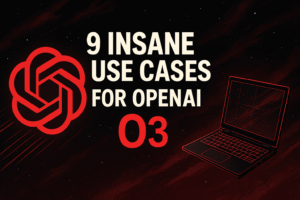The Dawn of a New AI Era
The world of artificial intelligence has just witnessed a seismic shift with the release of DeepSeek R1, a fully open-source AI model that rivals the best proprietary models, including OpenAI’s cutting-edge systems. This groundbreaking development not only democratizes access to advanced AI but also introduces a revolutionary concept: self-evolution. DeepSeek R1 is capable of autonomously improving its reasoning capabilities, a feat that could redefine the trajectory of AI development.
But what makes DeepSeek R1 truly remarkable? Beyond its open-source nature, it leverages reinforcement learning to create smaller, task-specific models through a process called distillation. This innovation empowers businesses, researchers, and even individual developers to harness the power of AI without the need for massive computational resources.
In this blog, we’ll explore the implications of DeepSeek R1, its technical breakthroughs, and how it’s challenging the status quo in the AI industry. Along the way, we’ll also discuss the broader impact of open-source AI on global innovation.
The Rise of DeepSeek R1: A Game-Changer in AI
What is DeepSeek R1?
DeepSeek R1 is the latest offering from the Chinese AI company DeepSeek, and it’s making waves for all the right reasons. Unlike proprietary models that are often locked behind paywalls and restrictive licenses, DeepSeek R1 is MIT-licensed, meaning it can be freely used, modified, and commercialized. This open-source approach is a direct challenge to industry giants like OpenAI, which have shifted towards more closed ecosystems.
Key features of DeepSeek R1 include:
- Performance on Par with OpenAI’s Best Models: It matches or even surpasses OpenAI’s 01 model in various tasks, including high-level reasoning and problem-solving.
- Distillation for Task-Specific Models: DeepSeek R1 can act as a “teacher” model, creating smaller, more efficient “student” models tailored for specific tasks like sentiment analysis or code generation.
- Accessibility: The model can run on consumer-level hardware, making advanced AI accessible to a broader audience.
The Aha Moment: Self-Evolution in AI
One of the most intriguing aspects of DeepSeek R1 is its ability to self-evolve. During its development, researchers observed what they called an “aha moment”—a phase where the model autonomously improved its reasoning capabilities without external adjustments. This self-evolution process is a testament to the power of reinforcement learning, where the model learns and adapts based on its interactions with the environment.
This capability is not just a technical milestone; it’s a philosophical shift. It suggests that AI can move beyond human-guided training to develop its own strategies for problem-solving, much like how AlphaGo mastered the game of Go by playing against itself.
Breaking Down the Technology: How DeepSeek R1 Works
Reinforcement Learning and Distillation
At the heart of DeepSeek R1’s capabilities is reinforcement learning. Unlike traditional supervised learning, which relies on labeled datasets, reinforcement learning allows the model to learn through trial and error. This approach was further enhanced by the use of distillation, a process where a large, complex model (the “teacher”) generates data to train smaller, more efficient models (the “students”).
For example:
- A 1.5 billion parameter distilled model from DeepSeek R1 achieved performance levels close to OpenAI’s GPT-4, despite being significantly smaller.
- A 14 billion parameter model outperformed many proprietary systems, demonstrating the scalability of this approach.
Emergent Behaviors: The Future of AI?
Another fascinating aspect of DeepSeek R1 is the emergence of sophisticated behaviors during training. These behaviors, such as self-reflection and re-evaluation of previous steps, were not explicitly programmed but arose naturally as the model interacted with its environment. This phenomenon, often referred to as emergent intelligence, is a hotly debated topic in AI research.
For instance, DeepSeek R1’s “zero model” (trained without human-labeled data) exhibited remarkable reasoning capabilities, albeit with some quirks like language mixing. This underscores the potential of reinforcement learning to unlock new levels of intelligence in AI systems.
Open-Source AI: A Double-Edged Sword?
The Democratization of AI
The open-source nature of DeepSeek R1 is a boon for innovation. By making advanced AI accessible to everyone, it empowers researchers, startups, and even hobbyists to experiment and build upon the technology. This aligns with the original mission of OpenAI, which aimed to democratize AI before shifting towards a more closed model.
Challenges and Risks
However, the open-source approach is not without its challenges. Critics argue that making such powerful technology freely available could lead to misuse, especially in the absence of robust ethical guidelines. Additionally, the release of DeepSeek R1 by a Chinese company raises geopolitical questions about the global AI race and the balance of power in technology.
Implications for the AI Industry
A Challenge to Proprietary Models
DeepSeek R1’s release is a direct challenge to proprietary models from companies like OpenAI and Anthropic. By offering comparable performance in an open-source package, it forces these companies to rethink their strategies. Will they double down on proprietary systems, or will they embrace a more open approach to stay competitive?
The Role of China in AI Innovation
The fact that DeepSeek R1 comes from a Chinese company is significant. It highlights the growing role of China in the global AI landscape, not just as a consumer but as a leader in innovation. This could have far-reaching implications for the future of AI development and regulation.
The Road Ahead for Open-Source AI
DeepSeek R1 is more than just a technical achievement; it’s a statement. It challenges the notion that cutting-edge AI must remain the domain of a select few companies. By embracing open-source principles, DeepSeek is paving the way for a more inclusive and collaborative AI ecosystem.
However, this democratization comes with its own set of challenges. As we move towards a future where AI systems can self-evolve and improve autonomously, the need for ethical oversight and global cooperation becomes more critical than ever.
So, what does the future hold? Will open-source AI like DeepSeek R1 become the norm, or will proprietary systems continue to dominate? One thing is certain: the AI landscape is changing, and DeepSeek R1 is at the forefront of this revolution.







